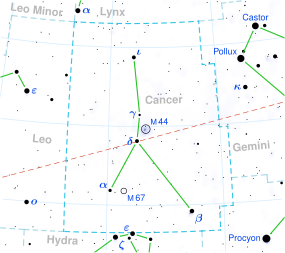
Summary
DX Cancri is a variable star in the northern zodiac constellation of Cancer. With an apparent visual magnitude of 14.81,[3] it is much too faint to be seen with the naked eye. Visually viewing this star requires a telescope with a minimum aperture of 16 in (41 cm).[14] Based upon parallax measurements, DX Cancri is located at a distance of 11.8 light-years (3.6 parsecs) from Earth. This makes it the 18th closest star (or star system) to the Sun.
| Observation data Epoch J2000 Equinox J2000 | |
|---|---|
| Constellation | Cancer |
| Right ascension | 08h 29m 49.345s[2] |
| Declination | +26° 46′ 33.74″[2] |
| Apparent magnitude (V) | 14.81[3] |
| Characteristics | |
| Spectral type | M6.5V[4] |
| Apparent magnitude (J) | 8.2[3] |
| U−B color index | +2.11[5] |
| B−V color index | +2.08[5] |
| Variable type | Flare star[3] |
| Astrometry | |
| Radial velocity (Rv) | +9.0[6] km/s |
| Proper motion (μ) | RA: −1,140[2] mas/yr Dec.: −602[2] mas/yr |
| Parallax (π) | 279.2496 ± 0.0637 mas[7] |
| Distance | 11.680 ± 0.003 ly (3.5810 ± 0.0008 pc) |
| Absolute magnitude (MV) | 16.98[8] |
| Details | |
| Mass | 0.09[8] M☉ |
| Radius | 0.11[9] R☉ |
| Luminosity | 0.00065[10] L☉ |
| Temperature | 2,840[11] K |
| Rotation | 0.46 days[9] |
| Rotational velocity (v sin i) | 11.0[12] km/s |
| Age | 200[13] Myr |
| Other designations | |
| Database references | |
| SIMBAD | data |
 DX Location of DX Cancri in the constellation Cancer | |
The star has a stellar classification of M6.5V,[4] identifying it as a type of main sequence star known as a red dwarf. It has about 9% of the mass of the Sun,[8] and 11% of the Sun's radius.[9] The outer envelope of the star has an effective temperature of 2,840 K,[11] making it an M-type star. It is a flare star that has random, intermittent increases in brightness by up to a factor of five. It is a proposed member of the Castor Moving Group of stars that share a common trajectory through space. This group has an estimated age of 200 million years.[15]
See also edit
References edit
- ^ Pettersen, B. R. (February 1981). "Discovery of flare activity on the very low luminosity red dwarf G 51-15". Astronomy & Astrophysics. 95: 135–137. Bibcode:1981A&A....95..135P. Retrieved 11 November 2021.
- ^ a b c d Zacharias, N.; et al. (2003). "The Second U.S. Naval Observatory CCD Astrograph Catalog (UCAC2)". VizieR Online Data Catalog. CDS/ADC Collection of Electronic Catalogues, 1289, 0 (2003). Bibcode:2003yCat.1289....0Z. Retrieved 2010-06-29.
- ^ a b c d e "V* DX Cnc -- Flare Star". SIMBAD. Centre de Données astronomiques de Strasbourg. Retrieved 2010-06-29.
- ^ a b Luhman, Kevin L.; Allers, Katelyn N.; Jaffe, Daniel T.; Cushing, Michael C.; Williams, Kurtis A.; Slesnick, Catherine L.; Vacca, William D. (April 2007), "Ophiuchus 1622-2405: Not a Planetary-Mass Binary", The Astrophysical Journal, 659 (2): 1629–1636, arXiv:astro-ph/0701242, Bibcode:2007ApJ...659.1629L, doi:10.1086/512539, S2CID 11153196
- ^ a b Weistrop, D. (August 1981). "The nature of the Giclas +4 stars". Astronomical Journal. 86: 1220–1227. Bibcode:1981AJ.....86.1220W. doi:10.1086/113001.
- ^ Montes, D.; et al. (November 2001). "Late-type members of young stellar kinematic groups - I. Single stars". Monthly Notices of the Royal Astronomical Society. 328 (1): 45–63. arXiv:astro-ph/0106537. Bibcode:2001MNRAS.328...45M. doi:10.1046/j.1365-8711.2001.04781.x. S2CID 55727428.
- ^ Brown, A. G. A.; et al. (Gaia collaboration) (2021). "Gaia Early Data Release 3: Summary of the contents and survey properties". Astronomy & Astrophysics. 649: A1. arXiv:2012.01533. Bibcode:2021A&A...649A...1G. doi:10.1051/0004-6361/202039657. S2CID 227254300. (Erratum: doi:10.1051/0004-6361/202039657e). Gaia EDR3 record for this source at VizieR.
- ^ a b c "The One Hundred Nearest Star Systems". RECONS. Georgia State University. January 1, 2009. Retrieved 2010-06-29.
- ^ a b c Morin, J.; et al. (October 2010), "Large-scale magnetic topologies of late M dwarfs", Monthly Notices of the Royal Astronomical Society, 407 (4): 2269–2286, arXiv:1005.5552, Bibcode:2010MNRAS.407.2269M, doi:10.1111/j.1365-2966.2010.17101.x, S2CID 119192200
- ^ Vidotto, A. A.; et al. (July 2013). "Effects of M dwarf magnetic fields on potentially habitable planets". Astronomy & Astrophysics. 557: A67. arXiv:1306.4789. Bibcode:2013A&A...557A..67V. doi:10.1051/0004-6361/201321504. S2CID 44335981.
- ^ a b Reiners, Ansgar; Basri, Gibor (February 2007). "The First Direct Measurements of Surface Magnetic Fields on Very Low Mass Stars". The Astrophysical Journal. 656 (2): 1121–1135. arXiv:astro-ph/0610365. Bibcode:2007ApJ...656.1121R. doi:10.1086/510304. S2CID 17743657.
- ^ Jenkins, J. S.; et al. (October 2009). "Rotational Velocities for M Dwarfs". The Astrophysical Journal. 704 (2): 975–988. arXiv:0908.4092. Bibcode:2009ApJ...704..975J. doi:10.1088/0004-637X/704/2/975. S2CID 119203469.
- ^ Lestrade, J.-F.; et al. (November 2009), "Search for cold debris disks around M-dwarfs. II", Astronomy and Astrophysics, 506 (3): 1455–1467, arXiv:0907.4782, Bibcode:2009A&A...506.1455L, doi:10.1051/0004-6361/200912306, S2CID 17035185
- ^ Sherrod, P. Clay; Koed, Thomas L. (2003), A Complete Manual of Amateur Astronomy: Tools and Techniques for Astronomical Observations, Astronomy Series, Courier Dover Publications, p. 9, ISBN 0486428206
- ^ Lestrade, J.-F.; et al. (December 2006), "Search for cold debris disks around M-dwarfs", Astronomy and Astrophysics, 460 (3): 733–741, arXiv:astro-ph/0609574, Bibcode:2006A&A...460..733L, doi:10.1051/0004-6361:20065873, S2CID 119328045
Further reading edit
- Dittmann, Jason A.; Irwin, Jonathan M.; Charbonneau, David; Berta-Thompson, Zachory K. (2014). "Trigonometric Parallaxes for 1507 Nearby Mid-to-late M Dwarfs". The Astrophysical Journal. 784 (2): 156. arXiv:1312.3241. Bibcode:2014ApJ...784..156D. doi:10.1088/0004-637X/784/2/156. S2CID 18789867. Table with parallaxes.
External links edit
- SolStation entry
- ARICNS
- http://www.richweb.f9.co.uk/astro/nearby_stars.htm



